Ground Report: What Really Happened in Violence-hit Telinipara, West Bengal
Telinipara (West Bengal): While the whole world has been fighting the novel coronavirus, Telinipara, a locality in the suburban West Bengal town of Bhadreswar, 40 km north of state capital Kolkata, has been fighting communal tension since May 12.
Telinipara, once famous for its jute industry, is located on the eastern edge of Hooghly district, beside the eponymous river, and is part of Hooghly parliamentary constituency. On the evening of Sunday, May 10, a small inter-community squabble broke out here, which was resolved by police intervention. Monday, May 11 passed without incident. Then, on the afternoon of Tuesday, May 12, a big mob descended on the locality and large-scale targeted violence followed. The district magistrate imposed Section 144 on the same day, and also suspended internet services in the adjoining Chandannagar and Shrirampur subdivisions of Hooghly district, within which Bhadreswar and Telinipara lie.
On Thursday, May 15, The Wire visited the areas where the violence took place in Telinipara. As we drove up the Grand Trunk (GT) road from Kolkata, we saw a completely charred shop at Babur Bazar junction in Bhadreswar, just before we turned right towards Telinipara. The name ‘Saad’ could still be spotted on the blackened wall. A mazhar (a Muslim shrine) opposite the Bhadreswar fire brigade station had been vandalised; from the road, we could see broken bricks and torn flags lying on the floor inside the shrine.
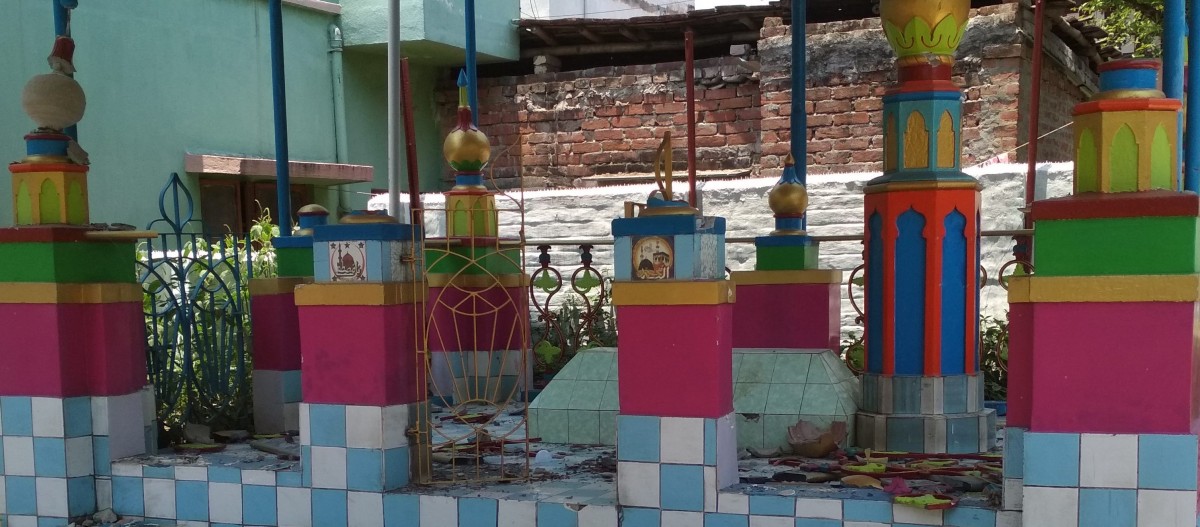
A vandalised mazhar in Bhadreswar. Photo: Himadri Ghosh
The atmosphere in Bhadreswar was calm, though we could hear people discussing the Telinipara incident as we passed a market. But the mood changed perceptibly once we turned right onto Dinemardanga street that led to Telinipara ghat.
This road had been partially barricaded by the police. The further we walked into the interiors of Telinipara, towards the spots where the violence occurred, we could see fewer people on the street. Fear was writ upon the faces of the few people who had ventured out.
Also Read: Islamophobia Is Worsening the Anxieties of the Lockdown
On nearing the end of Dinemardanga street, we spotted Specialised Indian Reserve Battalion (SIRB) personnel posted at a crossroad – Dinemardanga junction – just before Telinipara ghat. Around 30 SIRB personnel are posted at the junction round the clock, one of them confirmed to The Wire.

A goods carrier gutted by fire, Telinipara. Photo: Himadri Ghosh
From Dinemardanga junction, a road goes left towards the now defunct Gondalpara Jute Mill, which has been shut for over two years. A small lane cuts away to the right from the junction, going towards Ferry Ghat street. The road straight ahead ends at Telinipara ghat, a short distance away. The entire Dinemardanga street stretch from GT road to the junction is a predominantly Hindu neighbourhood, which we entered first.
We didn’t see any damaged houses or destruction of property on the entire road, barring two torched vehicles at the start of Dinemardanga street. The Wire verified the registration details of one of the vehicles from the Union Ministry of Road Transport and Highways website. The owner’s name is Gulam Sarwar Ansari. The owner of the other torched vehicle couldn’t be identified as its number plate was missing.
We tried to speak to a few people in the area about the May 12 violence but the common refrain was, “I don’t know anything.” When we asked a grocer if she knew who owned these burnt vehicles, she replied, “I don’t know.” She had the same answer to our query about when the violence took place.
An image of planned, systematic targeting emerged
We then walked towards the Gondalpara mill from Dinemardanga junction, and found a series of Muslim-occupied homes with broken doors, melted television cables and burnt, exposed electric wires. Some of the houses’ roofs and walls had fallen as gas cylinders had burst inside these small houses.
While inspecting the damage, we found black fumes were still emerging from two of the houses in the violence-hit lane. The road was completely covered with rubble - big stones, sticks, iron rods and uncountable broken bottles. Most of the bottles smelled of kerosene.
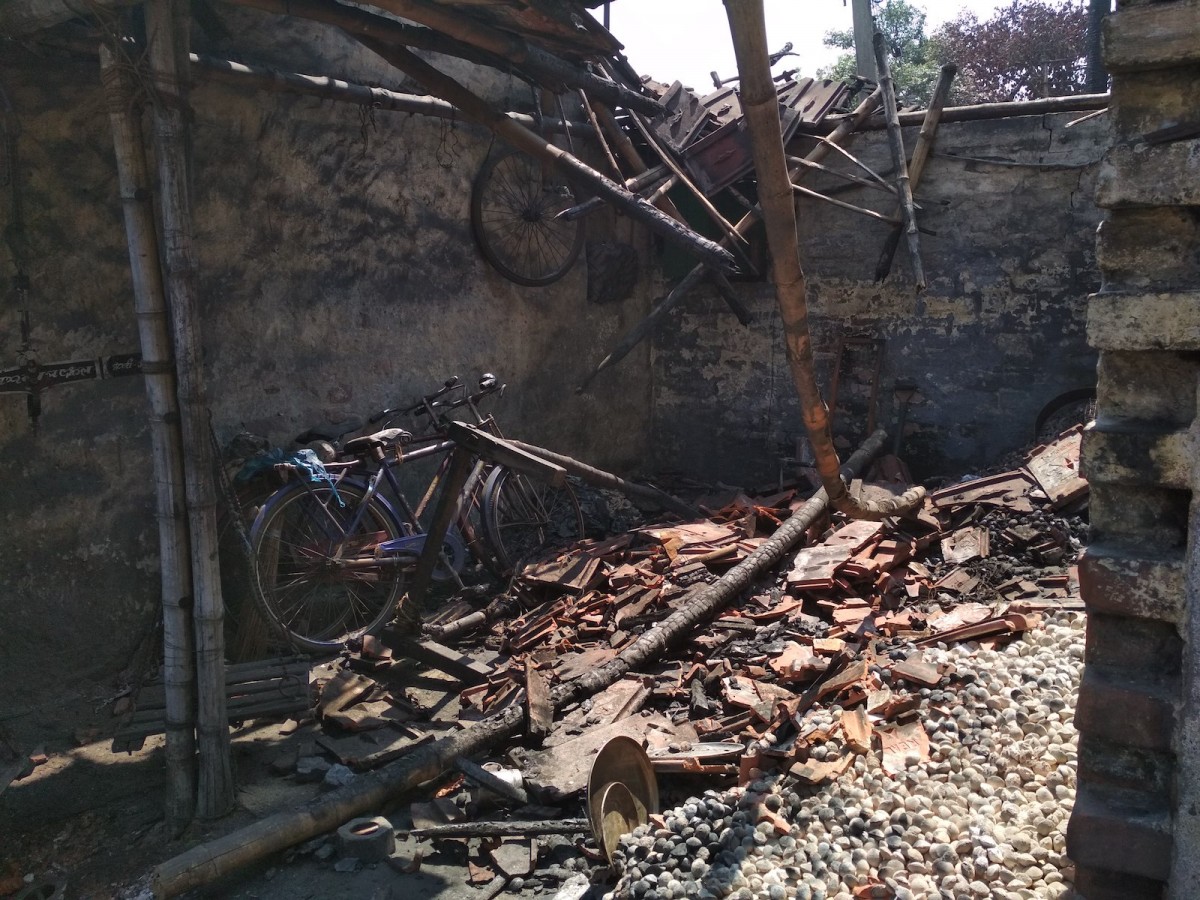
A house completely demolished by attackers, Telinipara. Photo: Himadri Ghosh.
We were astonished to find Muslim-owned photocopying, grocery and meat shops were scorched, while two Hindu-owned grocery and tailor shops stood intact next to them. We found several battery-operated rickshaws, motorbikes, cycles and a small tempo, all completely burned, on this street.
One house on the street, identifiable as belonging to a Hindu family with its ‘Om’ sign on the front door, was peculiarly damaged on only one side, while the other side appeared untouched. A local, who didn’t want to be named, said, “A cylinder burst in the Muslim house next to this (Hindu) house, and the impact damaged the wall of the latter house.”
A police officer present at the site was inspecting the damage. When asked if the violence was targeted at one community, he pointed towards a shop and said, “See, there is no damage to that shop. Now, read the name written on it.” The officer, speaking to The Wire on the condition of anonymity, said, “The attack was planned and some locals were involved. Otherwise it’s not possible for outsiders to pinpoint each house and target it. Also, the amount of petrol bombs used here shows that the attackers came well prepared.” He added that no further violence took place after May 12, and that the situation was now completely under control.

The aftermath of the communal violence which erupted in Telinipara. Photo: Himadri Ghosh
Mohammed Mustaque, 53, watched his house and shop being looted and torched by a mob of masked men on the afternoon of May 12. Mustaque is a cable operator in the area and runs a photocopying shop. “Those people were armed with iron rods, stones and petrol bombs and were chanting ‘Jai Shri Ram’. They wanted to destroy us. They burned down my new xerox machine. I pleaded to them with folded hands, but they didn’t listen. Now, we have nothing, other than what we are wearing,” a teary-eyed Mustaque told us in a choked voice.
We approached Mustaque’s 83-year-old father, who was sitting in one corner of the street. He broke down while holding our hands. He was unable to speak.
Shabana Khatun, Mustaque’s wife, told The Wire, “Apart from the photocopy shop which was charred, we have two more shops, both rented out to Hindus. Nothing happened to those shops. What more evidence do we need to prove we (Muslims) have been targeted?”
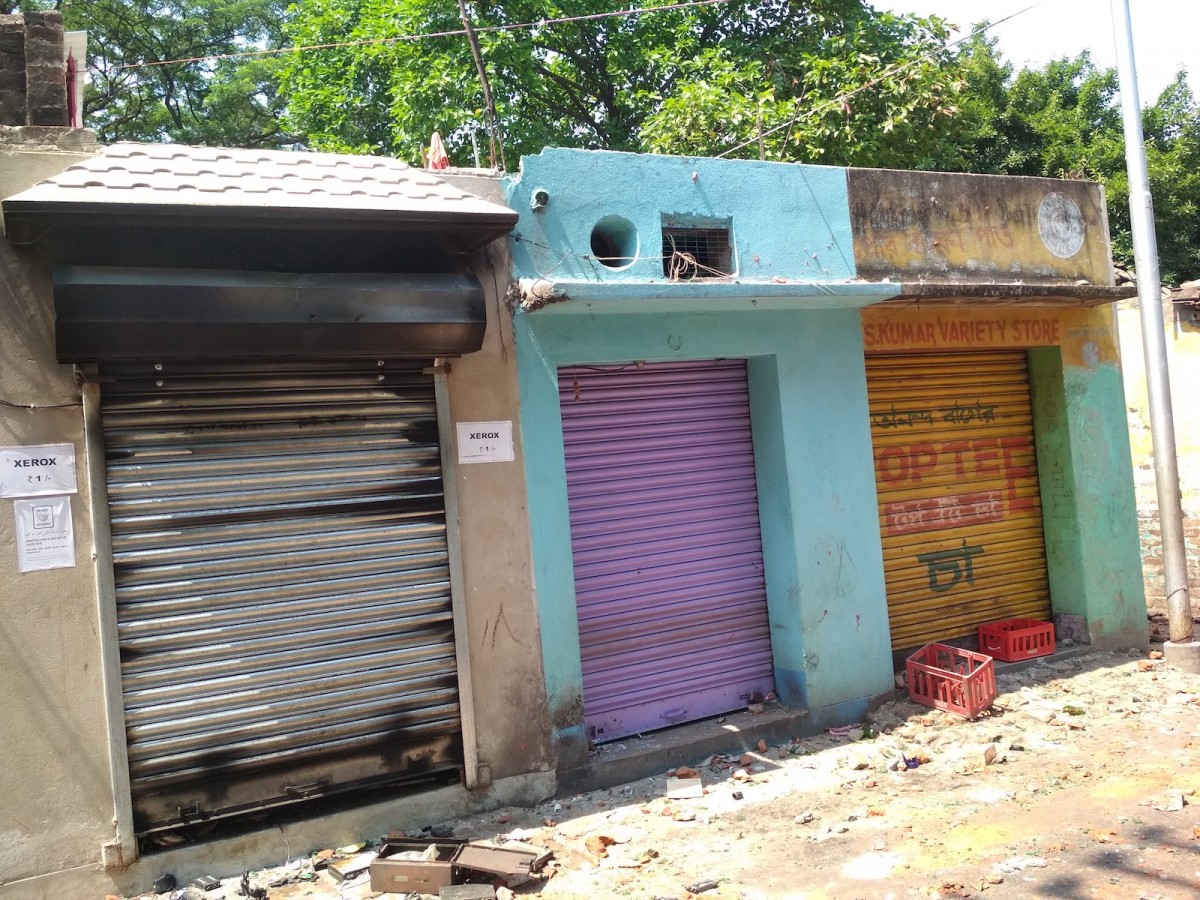
Mohammed Mustaque’s xerox shop burned by attackers, while the other two were not touched, Telinipara. Photo: Himadri Ghosh.
Locals alleged that the police responded very late, by which time a lot of damage was done. Mohammed Ansari, whose house was partly burned by petrol bombs and was also pelted with stones, said, “The whole incident started at around 12:30-1:00 pm on May 12. We got the news that some armed people had entered the Muslim area from the Gondalpara mill side, hurling bombs at Muslim houses. I dialled 100 to call the police. Then I tried calling Bhadreswar police, and I informed them about the situation. My brother called the fire brigade. However, the police came only after 2:30 pm. A lot of damage had been done by then. Also, only about 10-12 police came initially. They (the mob) attacked the police also, pelting stones at them. By the time police reinforcements arrived, it was 4 pm and the damage was already done.”
A small incident escalated into a mob attack
S.K. Shamsuddin, a retired jute mill worker, told us that the trouble actually began on Sunday, May 10 evening, after a minor brawl over the use of a public toilet near the Telinipara ghat. Shamsuddin’s neighbour Rajkumar Roy told us that someone from the minority area had reportedly tested positive for COVID-19. Fearing the spread of the virus, some members of the Hindu community stopped Muslims from using the public toilet, and this led to a small tussle. Another local, Dinesh Shaw, told us that this fight that had started on Sunday evening, ended the same night after police intervention, and nothing happened on Monday. “No one imagined that because of the coronavirus issue, there would be a riot the following day,” said Shaw.
On the day of the violence, Shamsuddin said he tried to stop the armed men rushing towards the Muslim area in Gondalpara, but one of them slapped him hard. “Hindu gwala brothers (milk-sellers) tried a lot to stop them. They helped us a lot. Otherwise, things would have been worse,” he said.
From Gondalpara, we went next to Ferry Ghat street, which forms part of ward 9 of Bhadreswar municipality. To reach it, one has to cross a narrow culvert which connects Dinemardanga junction to the masjid road. We found gas cylinders and a motorcycle lying in the drain beneath the culvert.
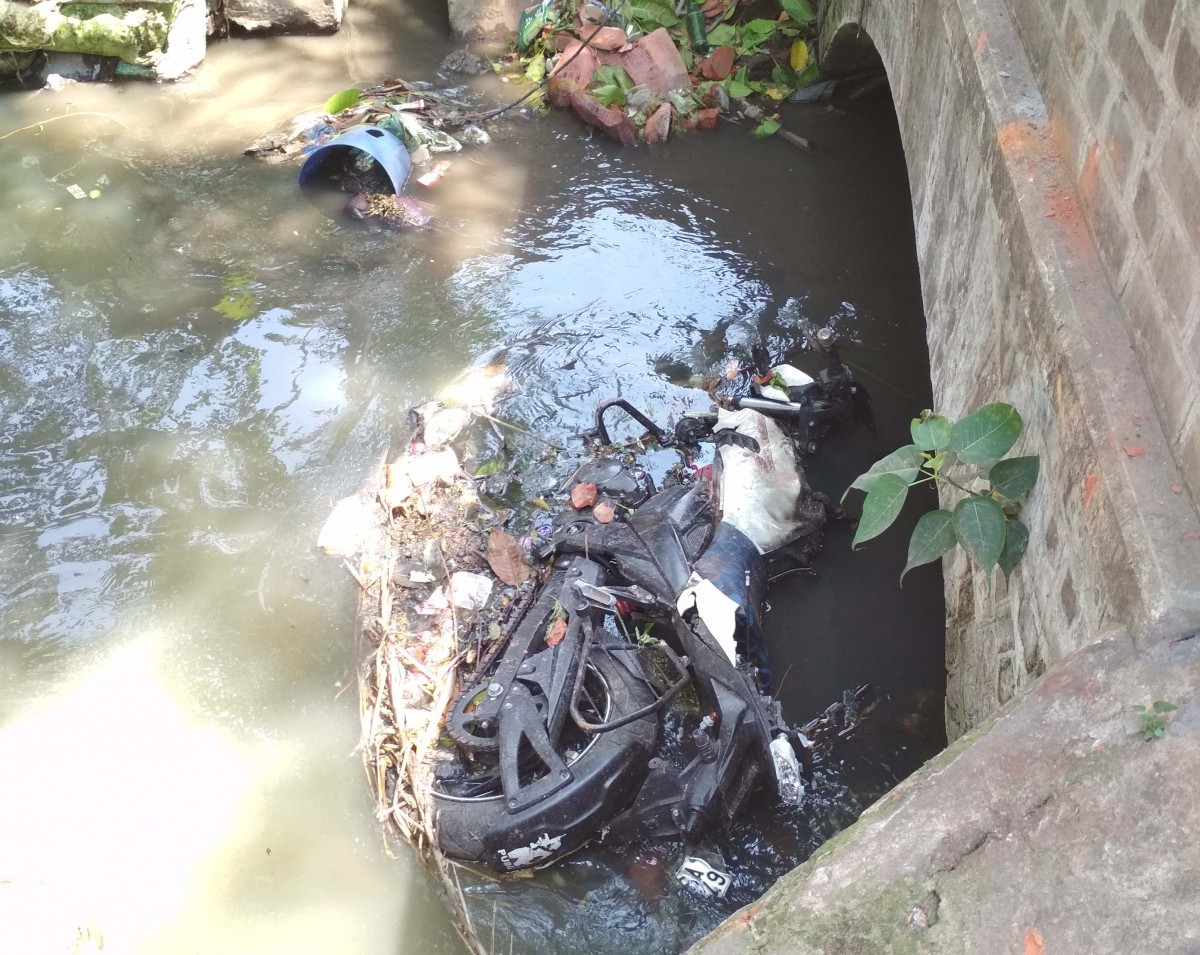
We spoke to two SIRB personnel who were sitting on the side of the culvert, both of whom had been on duty for over 11 hours. One of them said, “You (reporter) are checking the site. You can see whose properties were damaged. So many petrol bombs were used that the road is completely covered with pieces of glass. I guess they used acid too, as liquid from a bottle discoloured a wall.”
His companion said, “We only have lathis (sticks) and some non-lethal weapons. How can we control an armed mob of 500-600 bearing lathis and shields?”
We headed further into the interior lanes of north Telinipara. The lanes bore the scars of violence. People living in the tiny houses here fear for their lives.
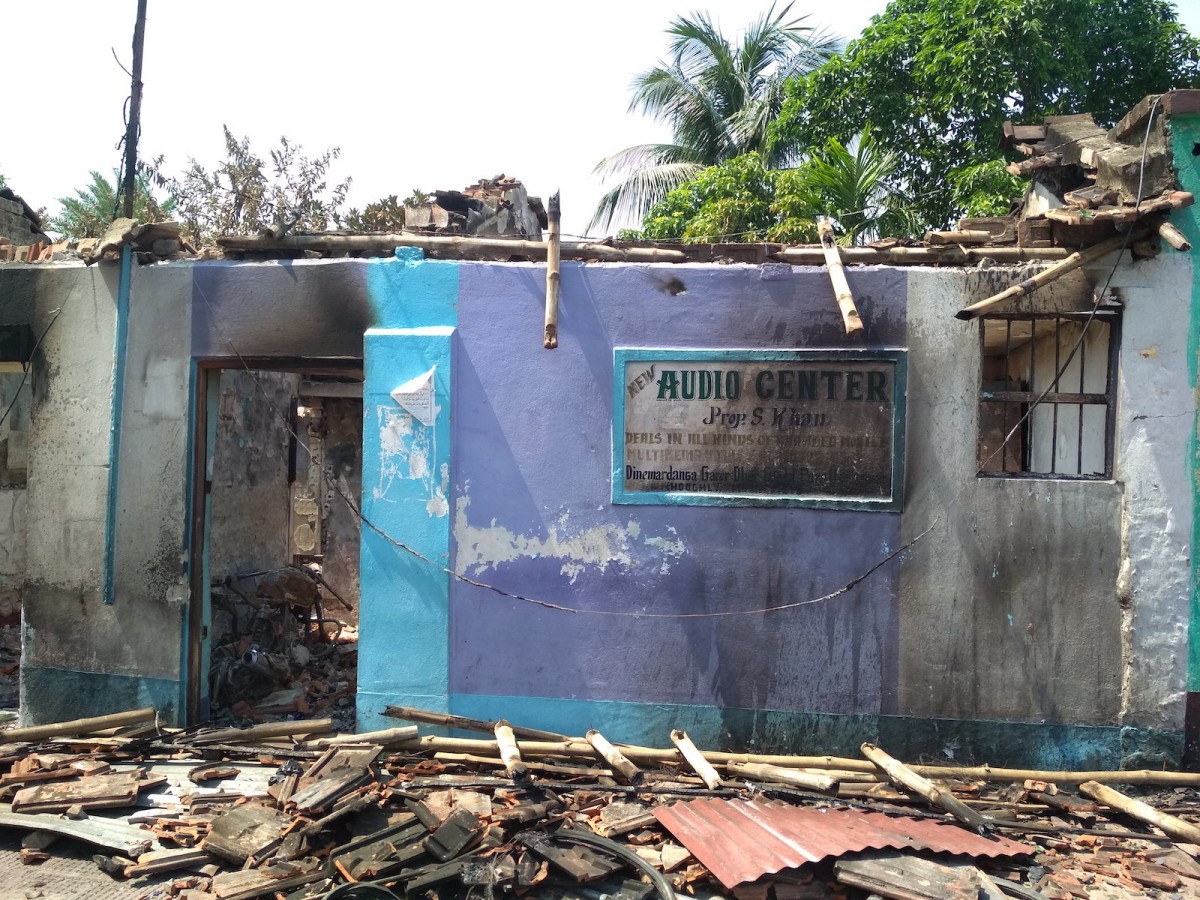
An audio center owned by S. Khan in Telinipara was entirely vandalised. Photo: Himadri Ghosh
We spoke with Biswanath Sikdar while he was reading a newspaper near a medical store, above which he lives. “Telinipara has witnessed small clashes between two communities many times in the past. But this time it was terrible. Both the communities are living in fear now,” Sikdar told The Wire.
'They came from across the river'
M.D. Salim, a Telinipara resident, narrated a horror story. “They came in such large numbers and with so much ammunition, we couldn’t even resist them,” he said. Showing us a torched house - which was part of a set of five houses, all sharing common walls with no spaces in between - he said, “This house caught fire and there was a cylinder inside. I rushed inside and took out the cylinder and covered it with sand. If I had come in a few minutes late, all these five houses would have been gutted in the fire,” he recalled.

Map of Telinipara in Hooghly district, West Bengal. Credit: Google Maps
The violence-hit area is surrounded by land on three sides and the river on one side. Gondalpara mill is located on the banks of the Hooghly and on the opposite bank is Jagatdal, which falls in Barrackpur district. The Jagatdal area forms part of the Barrackpur parliamentary constituency, whose sitting MP is the locally influential Bharatiya Janata Party (BJP) member of parliament (MP), Arjun Singh. Salim alleged that Singh’s men came in small boats to Telinipara from the direction of the Gondalpara mill.
We found that police sub-inspector M.D. Nihal’s house in the bylanes off Ferry Ghat street, had also been vandalised. One of the walls of his house bore severe cracks, due to the impact from a cylinder that had burst in the next house. Nihal’s house was locked. Locals told us that he was posted at Basirhat police station, near the international border in neighbouring North 24 Parganas district, and hence had moved there with his family.
Also Read: In Delhi, Hindutva Mobs Rage With Impunity as Police Watch in Silence
At the end of the same bylane, we met 50-year-old Zulfikar Ansari, a former Gondalpara jute mill worker. His house was also burned, with his father’s room on the second floor suffering particularly bad damage. Ansari told The Wire that the house next door belongs to the local councillor, but no one cared to intervene when the attack happened. “They hit my old father; I pleaded with them with folded hands, but they didn’t listen. They even took my cow. It was my only source of income after I lost my job.”
The Wire asked ward councillor Chitra Choudhury why she didn’t offer any help when her neighbours were attacked. Choudhury and her husband, both belonging to the Congress party, have between them held the councillor’s seat for over 25 year, continuously. “My son was with me at that time. Should I save myself, my son, or go to save others? Do you want me to stand in between when two groups are hurling bombs?” Choudhury countered. When we asked if she did not see it as her duty, as an elected representative, to at least meet the victims, she nonchalantly replied, “Do I have the ability to do anything, then why will I go to meet with the victims?”
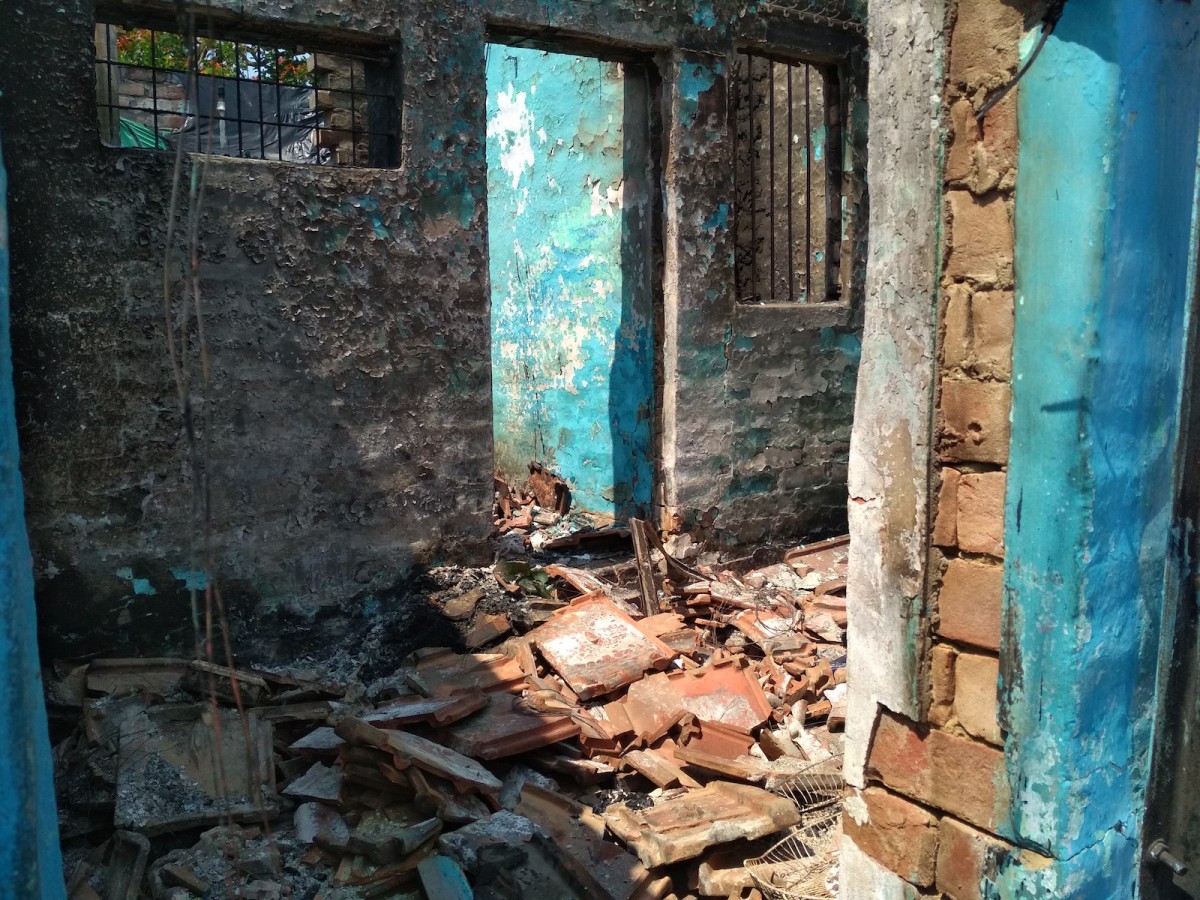
Locals said that not a single politician visited them. Many allege that the member of the state legislative assembly for Chandannagar, Indranil Sen of the ruling All Indian Trinamool Congress, hardly ever visits his constituency, in which Bhadreswar-Telinipara lie. They further alleged that Sen, who is also West Bengal’s minister of state for information and cultural affairs, becomes active only at the time of elections. Several calls and text messages The Wire sent to Sen went unanswered till the time of publication.
Speaking to The Wire, Chandannagar police commissioner Humayun Kabir said, “Sunday’s [May 10] incident was spontaneous, but Tuesday’s [May 12] incident was a pre-planned one and had been systematically organised. We arrested 91 persons within 24 hours, and placed them in front of the court. The court granted 14 days judicial custody. Around 35 persons were arrested the next day.”
Planting - and busting - a fake narrative of victimhood
We tried contacting Locket Chatterjee, the BJP MP for Hooghly. However, she has yet to answer our calls. Kailash Vijayvargiya, a BJP national general secretary and the party’s central observer for West Bengal, on May 12 afternoon tweeted a video of Chatterjee in which she is seen claiming, “Hindu houses were being burnt. I am getting a lot of distressed calls from the local people. This is a one-sided war.” She also lashed out at the state government machinery, saying “State administration is a mute spectator and Telinipara is burning.”
Also Read: The Coronavirus Has Morphed Into an Anti-Muslim Virus
A lot of fake news also circulated on social media, planting a similar narrative that Hindus were in danger in Telinipara. A Wikinews page dated Tuesday, May 12, 2020, bore the title “2020 Telinipara Anti-Hindu Pogrom.”
The Wire also found that a fake news website purporting to belong to Anandabazar Patrika - the largest circulated newspaper in Bengal - was spreading false and inflammatory news about the Telinipara incident. The ‘news’ portal, which became active on April 7, has subsequently been taken down.
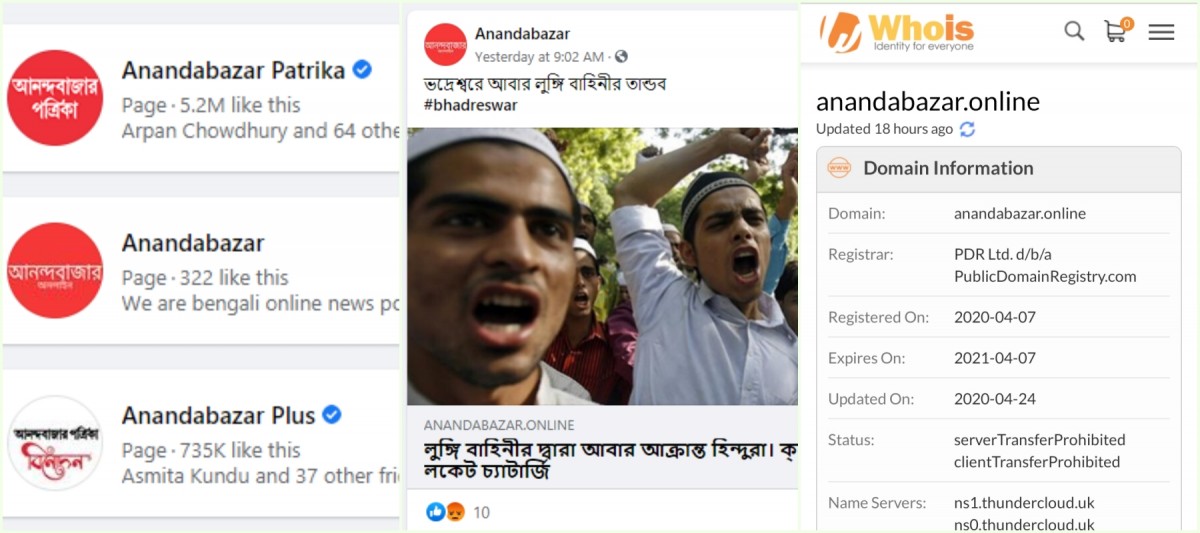
Screenshots of the fake Anandabazaar website, used by rightwing activists to push fake news about the Telinipara violence.
An India Today fact-checking team found that images of unrelated violence in another country were passed off as purported anti-Hindu riots in Telinipara, and widely circulated on social media. Twitter and Facebook users also shared these fake images. However, India Today busted the lies and said: “The pictures are from Pakistan, where members of the Hindu community were beaten up and their houses set ablaze.”
The Wire spent over three hours in violence-hit Telinipara, and spoke to multiple people from different communities. What we found on the ground was maximum damage in the Muslim neighbourhoods. We also found that some houses belonging to Hindu families in Raja Bazar were partially damaged. From all that we saw in Telinipara, our primary assessment is that what occurred on May 12 was a planned attack which was systematically executed. There is multiple evidence on the ground to show that Muslim houses and shops were singled out and strategically targeted. The locals allege that the attack was carried out by people coming from ‘outside’, aided by some locals familiar with the area.
This article went live on May sixteenth, two thousand twenty, at zero minutes past seven in the morning.The Wire is now on WhatsApp. Follow our channel for sharp analysis and opinions on the latest developments.




